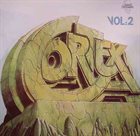 4.00
4.00 |
1 rating

FunkFreak75
The infectious popularity of Alain Mion's first CORTEX album obviously called for a follow up. The problem was in keeping his original band mates interested (and, I suppose, paid). Aside from drummer Alain Gandolfi (who, with Mion, would remain the core-constant throughout the Cortex career), an entire cast of newcomers has had to have been recruited in order to record an publish (and tour) with Alain's new songs.
A1. "Devil's Dance" (2:30) a great upbeat, piano & guitar-based Disco tune to open the album. Nice! New bassist Nicolas Mirkov and guitarist Philippe Vautin prove their worth from the opening minute. Even though it's short, it could easily (and happily) have been extended as a long jam (with perhaps some saxes or more solo work from Alain or Nicolas). (9.3333/10)
A2. "Funk Around The Punk" (3:18) definitely funk with the whole band--bass, drums, keys, and rhythm guitar--all participating in the wholeness of a 70s funk song. Guitarist Philippe Vautrin does some pretty cool things with his guitar: partly rhythmic, partly lead (small chords and both plucked and strummed strings). Alain Mion is active on several keyboard tracks indicating multiple over dubs. No horns or winds (that I can detect) on this one. Cute and peppy--very much like a BOB JAMES song. (8.875/10)
A3. "Hurluberlu" (5:10) two chord blues-based funk-rock/R&B with a rolling bass line and driving drum beat so that Alain and Philippe can play around on top. Nice, interesting work from Philippe's fuzzy-flanged lead guitar over this awesome cruisin' song. Excellent work from bassist Nicolas Mirkov (who, by the way, is the sole composer credited for this song) as well as from drummer Gandolfi. (9/10)
A4. "Soul" (2:50) three-chord keyboard entry leads into a funky Disco song with cool clavinet, rhythm guitar, and K.C. & The Sunshine Band "Get Down Tonight" lead guitar work, plus saxophone solos in the second half. Actually a pretty cool and creative song! (9/10)
A5. "Datura" (2:30) bass and guitar provide the most important inputs on this song. Though it has two motifs, it is another song that feels simple, one-dimensional, like a warm-up song or étude/practice/audition tune. One of the few songs not totally credited to Alain Mion, the guitar work of Philippe Vautrin is purely rhythm guitar but co-composer Nicolas Mirkov's bass (and sax) are plenty funky. (4.625/5)
B1. "Poxa" (3:25) this one sounds sappy enough to be a cover--like something that would likely end up as elevator music--but when the female background singers enter and start their "la-la-la-la-las" it kind of eliminates it from elevator heaven and renders it more of a soundtrack to some low-budget film. It's not bad--the musicians' performances are all fine--it's just a bit hokey. (8.75/10)
B2. "Mister J." (3:36) funky and perky little composition by drummer Alain Gandolfi that sounds like an American advertizing song. Female background vocalists enter in the second minute intermittently injecting the word some word that sounds perhaps more like "raina" than "régina." (8.875/10)
B3. "Régina" (5:00) the lone composition of guitarist Philippe Vautrin opens with guitar setting the chord progression, key, and pace. Funky bass, straightforward drums, keys, and clavinet "horns" plus real horns join in (the real horns gaining more traction the further into the song we go). (8.875/10)
B4. "Efficace Swing" (2:58) a nice little flute-led dittie that feels unfinished, more like an étude or practice song that never received the attention needed to finish it. Why is there no credit given to the flutist? (8.875/10)
B5. "Oh. Lord" (6:20) I love the etheric female vocalese singing like an angel over the church-like Hammond organ chords throughout the first half of this song. The little Hammond flurries in-between the two rounds of Alice Prévost's vocals is a little corny, but overall it's very cool. And then it ends. There is a rather long pause as if there is a whole new song starting, but I do recognize the same chords/key in the opening Fender Rhodes display. And then the bass, drums, and rhythm guitar-like chord play of Alain's left hand join in and provide a lovely funk-lite love song. (9.5/10)
Total Time: 37:52
The overall impression I have of this album is that it is a collection of interesting and fun ideas that the two Alains and their band mates were using for practice/workout sessions, most of which never really got fully developed or "polished." There are plenty of nice melodies and pleasant funk-lite grooves throughout, just nothing as amazing as the first album.
91.27 on the Fishscales = A-/five stars; though I really would not consider this a true masterpiece of top tier Jazz-Rock Fusion (like the first one was), the album is filled with brilliant, sometimes innovative ideas, excellent performances by all musicians involved and some great earworm-like ditties and hooks--and, of course, a core of silky-smooth funk!